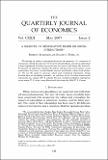| dc.contributor.author | Echenique, Federico | |
| dc.contributor.author | Fryer, Roland | |
| dc.date.accessioned | 2009-05-14T17:15:50Z | |
| dc.date.issued | 2007 | |
| dc.identifier.citation | Echenique, Federico, and Roland G. Fryer, Jr. 2007. A measure of segregation based on social interactions. Quarterly Journal of Economics 122, no. 2: 441-485. | en |
| dc.identifier.issn | 0033-5533 | en |
| dc.identifier.uri | http://nrs.harvard.edu/urn-3:HUL.InstRepos:2958220 | |
| dc.description.abstract | We develop an index of segregation based on two premises: (1) a measure of segregation should disaggregate to the level of individuals, and (2) an individual is more segregated the more segregated are the agents with whom she interacts. We present an index that satisfies (1) and (2) and that is based on agents' social interactions: the extent to which blacks interact with blacks, whites with whites, etc. We use the index to measure school and residential segregation. Using detailed data on friendship networks, we calculate levels of within-school racial segregation in a sample of U. S. schools. We also calculate residential segregation across major U. S. cities, using block-level data from the 2000 U. S. Census. | en |
| dc.description.sponsorship | Economics | en |
| dc.language.iso | en_US | en |
| dc.publisher | Massachusetts Institute of Technology Press | en |
| dc.relation.isversionof | http://dx.doi.org/10.1162/qjec.122.2.441 | en |
| dash.license | LAA | |
| dc.title | A Measure of Segregation Based on Social Interactions | en |
| dc.relation.journal | Quarterly Journal of Economics | en |
| dash.depositing.author | Fryer, Roland | |
| dc.identifier.doi | 10.1162/qjec.122.2.441 | * |
| dash.contributor.affiliated | Fryer, Roland | |


